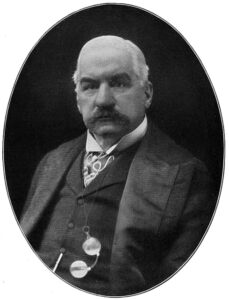
Charles Dickens

Dickens’s Desk in The Berg Collection at the New York Public Library’s branch at 5th Avenue and 42nd Street
Traditionally every holiday season the Morgan Library displays Charles Dickens’s only original manuscript of his novella A Christmas Carol. In drastic financial straits Dickens wrote the five “staves” or chapters of this iconic tale over six weeks at the end of 1843.
That he was in a hurry to finish is clear from the 66-page manuscript’s many revisions: detailed emendations, deletions, and insertions, and his scrawling handwriting. The book was published on December 19th and sold out by Christmas Eve. By the end of 1844 thirteen editions had been released and since then the novella has never been out of print.

The Ghost of Christmas Present
A Christmas Carol recounts the story of the money-lender Ebenezer Scrooge, an elderly miser who, on Christmas Eve, who is visited first by the ghost of his former equally miserly business partner and then by the spirits of Christmas Past, Present, and Yet to Come. Thanks to them, Scrooge, who’d always hated Christmas until then, wakes up on Christmas morning a changed man. He makes a large donation to charity, sends a turkey to his clerk’s family, and even attends a family party. From then on, he treats everyone with goodwill generosity, and sensitivity, embodying the Christmas spirit.
When the manuscript was returned by the printer, Dickens sent it to a bookbinder (probably Thomas Robert Eecles on London’s Curistor Street, just off Chancery Lane and near Fleet Street), who bound it in crimson Morocco, a durable goatskin leather. The binding was then elegantly decorated in glit with the name “Thomas Mitton Esqre” stamped on the front cover. Mitton (1812-78), a solicitor, was a close friend of Dickens and his creditor so Dickens gave him this bound manuscript as a Christmas present to thank him for a loan of 270 pounds. The manuscript then passed on to several different owners until the banker, businessman, art and book collector J.P. Morgan bought it in the 1890s. (Incidentally Morgan died in Rome on March 31, 1913, while on holiday and staying at the Albergo Roma, the future Grand Hotel).
Beginning a few years ago The Morgan started advancing the Christmas Carol manuscript by one page each season. This year’s passage is from the beginning chapter. Scrooge is alone. He has sent away two charity workers seeking donations for the poor, reluctantly given his overworked, underpaid clerk Bob Chratchit Christmas Day off and turned down a dinner invitation from his ebullient nephew Fred. Marley’ ghost still has to arrive.

Clement Clarke Moore
This year’s Christmas exhibition, on until January 5, includes a special gift: the donation of the earliest manuscript of the poem “A Visit from St. Nicholas” (better known as “The Night Before Christmas”) by Clement Clarke Moore and illustrated by his daughter Mary Clarke Moore Ogden

Title page
.

Mary Clarke Ogden’s dedication n page showing an illustration of the houwswhere she grew up
Clement Clarke Moore (1779-1863), a professor of ancient Greek and Hebrew at Columbia University and devotee of Italian lyric opera, wrote “A Visit from St. Nicholas” in 1822. Supposedly a family friend sent a copy to the Troy Sentinel, the newspaper in Troy, New York, which published it anonymously on December 23, 1823. Moore’s authorship wasn’t authenticated until 1837.
Moore’s daughter, Mary Clarke Moore Ogden (1819-1893) illustrated the manuscript and gave it to her husband John Doughty Ogden as a Christmas present in 1855. On the page opposite her dedication to her husband she drew her family house in Manhattan’s West Side Chelsea neighborhood where she’d grown up and with her eight brothers and sisters heard their father recite his poem every Christmas. David Ogden, Mary’s great grandson, recently donated this family treasure illustrated with beautiful color miniature vignettes and decorative floral borders similar to those in medieval manuscripts. He’d just turned 100 years old as had the Morgan Library and Museum. For in 1924 J.P. Morgan’s son, also named J.P. Morgan, in accordance with his father’s will, opened the family home as a public research library and museum.
Just as I was about to submit my story, an article by James Barron, appeared in the New York Times, appropriately on December 6, which is St. Nicholas Day. It recounted that Christie’s auction house, had been offered the fifth known manuscript of Moore’s poem. The asking price is $500,000. It belongs to relatives of Adrian Van Sinderen, a prominent book collector who died in 1963. No one knows how he obtained this manuscript, but, according to his obituary in the Times, Van Sinderen wrote 25 books about Christmas.

J.P. Morgan’s Study

J.P. Morgan
J.P. Morgan’s personal library and study as well as the exhibition rooms are open to visitors on Tuesday, Wednesday, Thursday, Saturday and Sunday from 10:30 AM to 5 PM, and on Friday from 10:30 AM to 8 PM. Admission is $25 for adults, $17 for seniors (65 and over), $13 for students (with current ID), and free for children 12 and under (who must be accompanied by an adult).
The Morgan Library and Museum is located at 225 Madison Avenue at 36th Street in Manhattan, a five-minute walk from the no. 6 subway stop at 33rd Street and with several Madison Avenue buses stopping right in front of its main entrance. Renzo Piano, the genovese architect, in 2006 designed its glassed-in courtyard with a café, called Morgan Café, open Tuesday-Sunday from 11AM to 4 PM. The Library has a restaurant as well, appropriately called The Dining Room. It’s located in the Morgan family’s dining room and is open from 9 AM to 5PM. For reservations telephone 212-685-0008.
Within a five-minute walk, I can also recommend Serafina for Italian cuisine, Pera for authentic eastern Mediterrean, Zuma and Wokuni for Japanese and Benjamin’s or Wolfgang’s Steakhouses.
